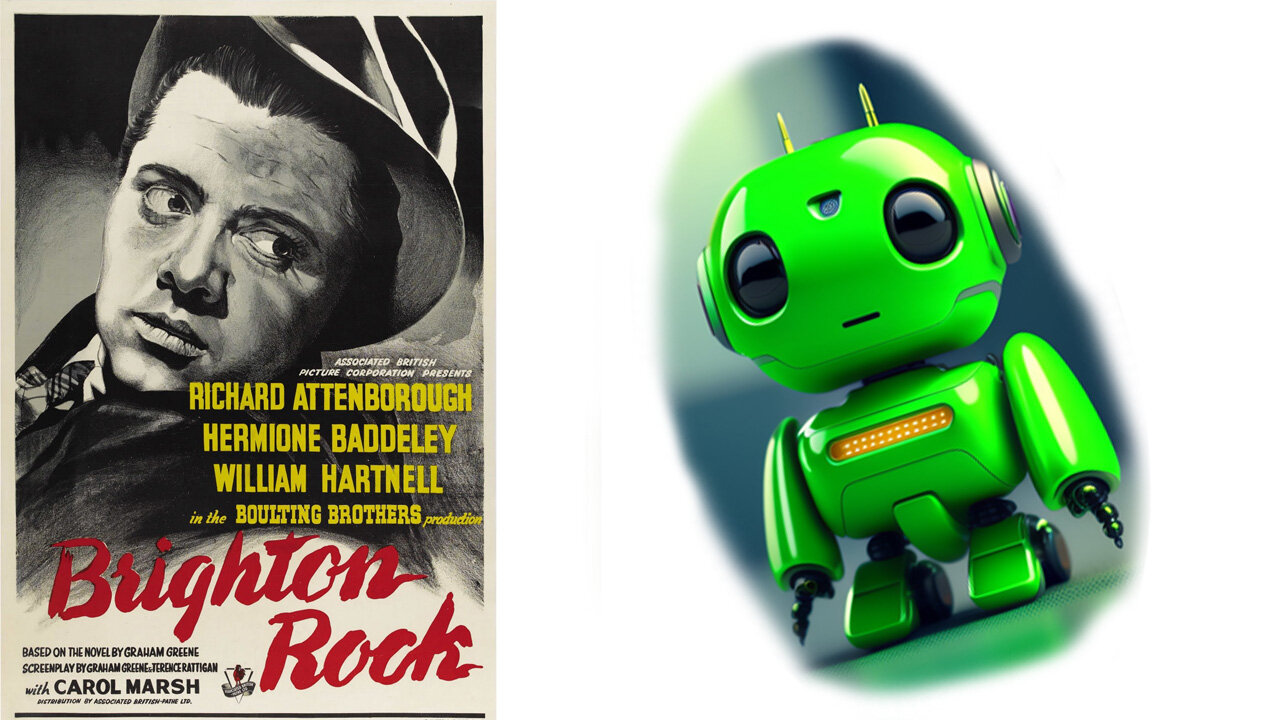Premium Only Content

'Brighton Rock' (1948) Movie of the Book by Graham Greene
Directed by John Boulting, 'Brighton Rock' is a gripping British crime thriller adapted from Graham Greene’s 1938 novel of the same name. The film blends the tension of a gangster noir with the moral complexity characteristic of Greene’s work, offering a chilling exploration of violence, guilt, and the clash between good and evil.
Plot Overview:
Set against the seedy underbelly of Brighton’s seaside resort, the story follows Pinkie Brown (played by Richard Attenborough), a cold-blooded teenage gangster who takes over a protection racket. After murdering a journalist investigating the gang’s activities, Pinkie becomes entangled with an innocent waitress named Rose (Carol Marsh) who holds vital evidence against him. To prevent her from testifying, he manipulates her into marriage. Meanwhile, the sharp-witted and morally determined Ida Arnold (Hermione Baddeley) suspects foul play and pursues justice relentlessly.
Performances:
Richard Attenborough delivers a career-defining performance as Pinkie. He perfectly captures the character’s chilling sociopathy beneath a veneer of youthful charm. His cold stare and restrained menace make Pinkie one of the most unsettling villains in British cinema. In contrast, Carol Marsh’s portrayal of the naïve and vulnerable Rose is heartbreaking, while Hermione Baddeley provides a lively, dogged counterbalance as the justice-seeking Ida.
Direction and Cinematography:
John Boulting’s direction effectively heightens the tension and moral ambiguity. The film’s cinematography, by Harry Waxman, uses the chiaroscuro lighting typical of film noir to reflect the dark psychological landscape. Brighton’s pier and fairground—usually symbols of leisure—become haunting settings for violence and moral decay. The film’s shadowy visuals emphasize the constant threat of danger lurking beneath everyday life.
Themes:
The film, like the novel, explores Catholic notions of sin, damnation, and redemption. Pinkie’s internal conflict between his criminal instincts and religious fears is central to the narrative. His manipulation of Rose highlights the power dynamics between innocence and corruption. Ida, representing a more earthly sense of morality, contrasts with Pinkie’s rigid, fear-driven Catholicism.
Differences from the NovelL
While the film remains largely faithful to Greene’s novel, the ending was softened due to the stricter censorship of the time. Where the novel leaves the audience with a bleak, uncompromising conclusion, the film hints at the possibility of redemption—though still underscored by a sense of inevitable tragedy.
Legacy and Impact:
Brighton Rock is considered a landmark in British cinema. Attenborough’s portrayal of Pinkie set a new standard for on-screen villains and influenced subsequent portrayals of youthful criminality. The film’s combination of moral inquiry and noir aesthetics helped elevate British crime films beyond mere entertainment into the realm of serious social commentary.
Conclusion:
A compelling mix of crime thriller and moral fable, Brighton Rock remains a powerful and unsettling classic. With its tense narrative, striking performances—especially from Attenborough—and atmospheric cinematography, it continues to resonate as a meditation on evil and innocence. For fans of Graham Greene, film noir, or psychological dramas, this is essential viewing.
-
 LIVE
LIVE
GritsGG
11 hours agoWin Streaking! Most Wins 3485+ 🧠
90 watching -
 LIVE
LIVE
Quite Frankly
5 hours ago"Mixed News, RFK Pull-up Challenge, Calls" ft. J Gulinello 8/28/25
503 watching -
 1:14:52
1:14:52
TheCrucible
3 hours agoThe Extravaganza! EP: 29 (8/28/25)
69.5K7 -
 1:09:58
1:09:58
Kim Iversen
3 hours agoTrans. Russian. Anti-Israel. Anti-Trump. Are You Buying This Story?
18.1K59 -
 1:51:08
1:51:08
Redacted News
3 hours agoEMERGENCY! BILL GATES CULT MEMBERS FOUND PLANTED INSIDE MULTIPLE FEDERAL AGENCIES, RFK FURIOUS
129K87 -
 31:02
31:02
Kimberly Guilfoyle
4 hours agoFull Breaking News Coverage: Live with John Nantz & Steve Moore | Ep250
20.4K13 -
 1:15:19
1:15:19
vivafrei
5 hours agoShameless Politicization of Tragedy! Susan Monarez is OUT! Pritzker is an IDIOT! & MORE!
130K49 -
 9:52
9:52
Tundra Tactical
3 hours agoCracker Meme Review On Tundra Meme Review!!
9.93K -
 LIVE
LIVE
Wayne Allyn Root | WAR Zone
6 hours agoWAR Zone LIVE | 28 AUGUST 2025
94 watching -
 LIVE
LIVE
LFA TV
12 hours agoLFA TV ALL DAY STREAM - THURSDAY 8/28/25
861 watching